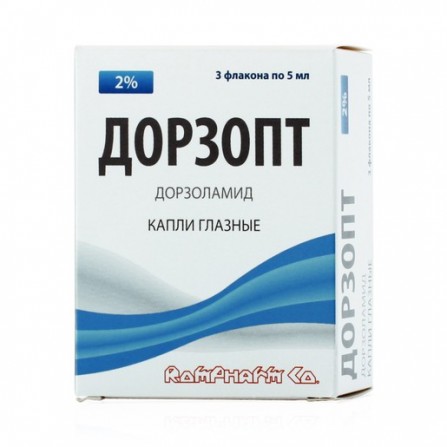Dorzopt eye drops 2% 5 ml N3
Condition: New product
1000 Items
Rating:
Be the first to write a review!

More info
Active ingredients
Dorzolamide
Release form
Drops
Composition
Active ingredient: Dorzolamide Concentration of active ingredient (mg): 20 mg
Pharmacological effect
Antiglaucoma drug, local carbonic anhydrase inhibitor. Reduces the secretion of intraocular fluid, slowing the formation of bicarbonate, followed by a weakening of the transfer of sodium and water. Does not cause accommodation spasm, miosis, hemeralopia.
Pharmacokinetics
Absorption Penetrates the eye mainly through the cornea (to a lesser extent through the sclera or limb). Systemic absorption is low. After entering the blood, it quickly penetrates into red blood cells containing a significant amount of carbonic anhydrase II. Distribution and metabolismBinding to plasma proteins is 33%. It is transformed into an N-dezetilirovanny metabolite, less active in relation to carbonic anhydrase II, but capable of blocking carbonic anhydrase I. With prolonged use it accumulates in erythrocytes. After the abolition of the rapid phase of elimination is replaced by a slow, due to the gradual release of the drug from the red blood cells, with T1 / 2 about 4 months.
Indications
Open-angle (incl. Secondary) glaucoma; pseudoexfoliative glaucoma; ophthalmic hypertension.
Contraindications
Hypersensitivity to any component, chronic renal failure (creatinine clearance less than 30 ml / min), hyperchloremic acidosis, children under 18 years of age, pregnancy, breastfeeding period, oral intake of carbonic anhydrase inhibitors. With caution Diabetes, liver failure, corneal diseases , use in patients after antiglaucomatous operations (risk of eye hypotonia, retinal detachment).
Precautionary measures
Do not exceed the recommended dose. With caution, the drug is prescribed for diabetes, liver failure, corneal diseases, use in patients after antiglaucomatous operations (risk of eye hypotension, retinal detachment).
Use during pregnancy and lactation
The drug is contraindicated in pregnancy and lactation (breastfeeding).
Dosage and administration
Instill 1 drop in the affected eye 3 times a day; in combination with beta-blockers for local use - 1 drop 2 times a day. If several local ophthalmic drugs are used in the treatment, they should be administered at intervals of 10 minutes.
Side effects
Local: burning, paresthesia, itching in the eyes, tearing, blurred vision, irritation and swelling of the eyelids, conjunctivitis, superficial punctate keratitis, blepharitis, photophobia; rarely - iridocyclitis, an increase in corneal thickness, allergic reactions; eye hypotonia, retinal detachment in patients after antiglaucomatous operations. Systemic: bitter taste in the mouth, nausea, headache, asthenia, nephrourolithiasis, malignant exudative erythema (Stevens-Johnson syndrome), toxic epidermal necrolysis (Lyell's syndrome), agranulocytosis, aplastic anemia, skin rashes.
Overdose
Symptoms: violation of water and electrolyte metabolism, acidosis, disorders of the central nervous system. Treatment: symptomatic therapy is carried out. It is necessary to control the level of electrolytes (especially potassium) and the level of blood pH.
Interaction with other drugs
Antiglaucoma drugs (beta-blockers, pilocarpine, dipivefrin, carbachol) increase the effect of dorzolamide. If used simultaneously with acetazolamide, the risk of systemic side effects increases. There is a possibility of increased toxicity when taking large doses of acetylsalicylic acid.
special instructions
The preservative benzalkonium chloride contained in the preparation can be adsorbed by soft contact lenses, causing eye irritation and toxic effect. The drug is used only after removing the contact lenses. Contact lenses should be installed no earlier than 15 minutes after instillation. You need to control the content of potassium, electrolytes in the blood serum and its rN. In elderly patients, sensitivity to dorzolamide may be increased, therefore, this category of patients may require a dose reduction. driving and operating mechanisms. During the period of treatment, care must be taken when driving vehicles and engaging in other potentially hazardous activities that require shennoy concentration and speed of psychomotor reactions.




